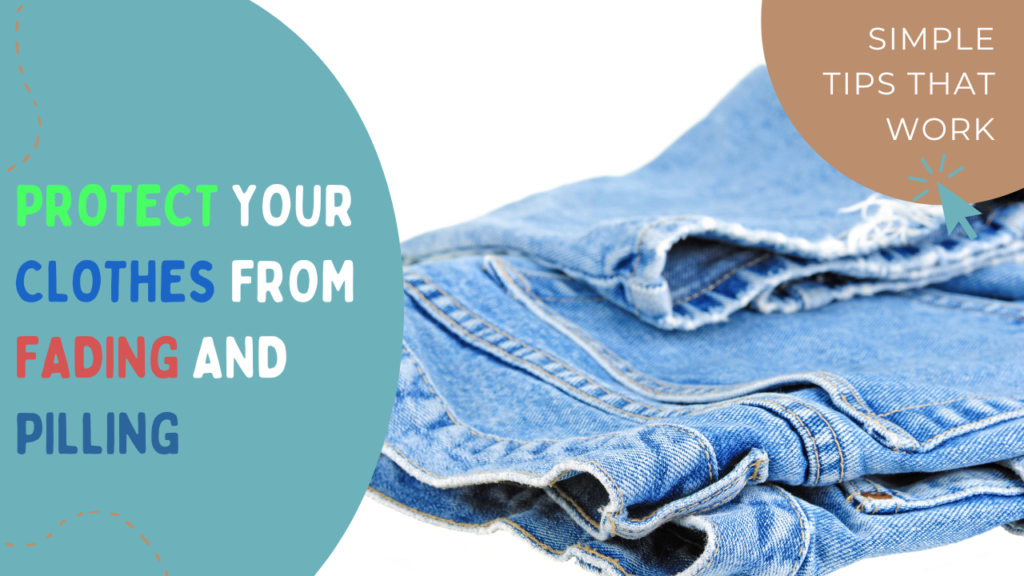Nothing’s worse than seeing your favorite clothes lose their charm after just a few washes. Fading colors and pesky fabric pills can make even the best outfits look dull and worn out. But here’s the good news: with the right care, you can keep your go-to pieces looking fresher, longer. By making small changes to how you wash, dry, and store your clothes, you’ll not only save their appearance but also extend their lifespan. Let’s get started on protecting the clothes you love most.
Understanding Why Clothes Fade and Pill
Have you ever wondered why your favorite clothes seem to lose their vibrance or develop those annoying little fuzz balls over time? It’s frustrating, but understanding the causes of fading and pilling can empower you to take steps to prevent them.
What Causes Fading?

Photo by Anastasia Shuraeva
Fading happens when the color in your garments starts to break down, and there are a few common culprits behind this process:
- Sunlight and UV Rays: Think of sunlight as bleach for your clothes. Ultraviolet (UV) rays break down the dye molecules, leaving your fabrics looking dull and washed out over time. Hanging clothes to dry in the sun? It might be doing more harm than good for their color.
- Washing in Hot Water: Hot water can be a color’s worst enemy. Why? Heat opens up the fibers in fabric, which allows dye to escape during washes. That’s why dark jeans fade faster if washed improperly.
- Harsh Detergents: Some detergents are too aggressive and strip colors faster than you’d expect. Those marketed for deep cleaning often contain enzymes or bleach components that aren’t dye-friendly, especially for delicate clothing.
To top it off, the friction from rough wash cycles can expedite color loss. You might not notice it at first, but over time, it adds up.
What Causes Pilling?
Pilling is one of those things that makes clothes lose their polished look, even if they’re clean. So, what exactly is it? Pilling occurs when loose fibers on a garment’s surface tangle together into tiny balls. Here’s why it happens:
- Friction from Wear or Washing: Imagine your clothes rubbing against a backpack strap or getting tossed around with heavy items in the washer. This friction loosens the small fibers, and they start clumping together.
- Fabric Type Matters: Clothes made of synthetic fibers like polyester and nylon are more prone to pilling. These fibers are stronger and don’t break off as easily, so they stay tangled on the fabric. Natural fibers like cotton and wool can pill too, but they shed pills more readily—meaning the fuzz balls fall off instead of sticking around.
- Looser Weaves or Knits: Lightly woven fabrics allow more movement between fibers, making clothes like sweaters or soft T-shirts prone to pilling. Thicker, tighter weaves tend to resist pills better.
- Blended Fabrics: Those popular cotton-polyester blends? While they’re comfy, the mixed fibers often behave differently during wear, which contributes to pilling.
Addressing pilling doesn’t mean avoiding these fabrics altogether but understanding where they’re most at risk. For instance, a wool sweater might pill on the sleeves or sides where your arms frequently move.
By tackling both fading and pilling head-on, you can keep your wardrobe looking vibrant and professional for longer.
Best Practices to Prevent Fading
Keeping your clothes vibrant and looking new doesn’t have to be complicated. With a few strategic changes, you can avoid dull, washed-out fabrics and instead prolong the life of your wardrobe. Here are actionable tips to safeguard your favorite pieces.
Sorting Laundry Properly
Sorting might feel tedious, but it plays a key role in preventing color bleed and fabric damage. Always sort your laundry by color (dark, light, whites) and fabric type (delicates, denim, synthetics). Darker dyes, like in black or red fabrics, tend to bleed more and can easily ruin lighter clothes. Separating fabrics also prevents rougher materials, like jeans, from rubbing against delicate fabrics, which could weaken their fibers. Think of sorting like a VIP list for your washing machine—only compatible items should mix.
Use Cold Water for Washing
Want to save your fabrics and the environment at the same time? Stick to cold water washes. Hot water opens up fabric fibers, making it easier for dyes to escape. On the other hand, cold water keeps fibers tighter, locking in the color. This is crucial for darks, brights, or any item with a bold print. Plus, switching to cold water reduces energy use, which is a win-win for both you and your clothes.
Turn Clothes Inside Out
Before tossing your clothes into the washer, turn them inside out. Why does this matter? When the visible surface is protected, it endures less friction during cycles. This simple flip keeps the outer layers safe from wear that fades colors or peels off printed designs. Think of it as adding a protective shield—your prints and color patterns will thank you.
Choose the Right Detergents
Not all detergents are created equal. Opt for liquid detergents specifically designed for dark or colorful clothes. These are gentler and lack the harsh additives, like bleach, that can strip away brightness. Powder detergents often don’t dissolve fully in cold water and could leave residue, which dulls your clothes over time. When in doubt, check the product label for phrases like “color-safe” or “designed for darks.”
Air Dry Over Machine Drying
Machine drying may be convenient, but the high heat is a notorious culprit of fading. Heat weakens fabric fibers, making colors look washed out faster. Whenever possible, air-dry your clothes by hanging them out of direct sunlight. If air-drying isn’t an option, a low-heat dryer setting can help minimize damage. Remember, the sun’s UV rays are just as harmful to your clothes as they are to your skin—keep garments safe in the shade!
Best Practices to Prevent Pilling
Pilling often steals the charm from your favorite clothes, leaving them looking unpolished and aged. But don’t worry—it’s not unavoidable. With a little effort and smart practices, you can limit pilling and keep your wardrobe looking fresh. Here’s how.
Avoid Overloading the Washing Machine
Did you know overloading your washing machine is one of the quickest ways to invite pilling? When the drum is packed too tightly, there’s less room for water and detergent to circulate freely. This causes your clothes to rub against each other excessively, creating the friction that leads to those annoying fabric pills.
To prevent this, keep loads manageable. Follow your machine’s load guidelines to ensure every item gets cleaned without being subjected to unnecessary wear. If your clothes are jostling for space in the drum, it’s time to remove a few. Simplifying your laundry loads can make a big difference in the long-term health of your clothing.
Use Fabric Softeners or Conditioners
Fabric softeners and conditioners are more than just laundry aisle extras; they’re your fashion’s secret defense against pilling. These products coat your clothes’ fibers, making them smoother and less prone to breaking under stress.
Here are a few recommended options:
- Liquid Fabric Conditioners: Ideal for preventing pilling during machine washes.
- Natural Alternatives: If you’re eco-conscious, vinegar can be a gentle fabric softener substitute. Just add a small amount to the rinse cycle.
Using these products reduces friction during both washing and drying cycles, ensuring your clothes remain smooth and pill-free.
Wash Delicates Separately
Delicates and heavy fabrics simply don’t belong in the same wash cycle. Items like lingerie, silk shirts, or fine-knit sweaters are especially prone to pilling when thrown in with rougher fabrics like denim or towels.
To protect delicate garments:
- Handwash when possible to minimize agitation.
- Use a mesh laundry bag if you prefer a machine wash. It acts as a shield that keeps delicate fabrics safe while still getting them clean.
This extra effort ensures delicate fabrics maintain their soft texture and original shape.
Choose Gentle Wash Cycles
Your washing machine’s “delicate” or “gentle” cycle isn’t there for decoration—it’s a must-use for fabrics you want to preserve. These cycles reduce agitation, which is the primary cause of fiber loosening and, ultimately, pilling.
Here’s why gentle cycles make sense:
- They have slower spin speeds, minimizing harsh movement.
- They minimize temperature fluctuation, which is less stressful on fibers.
For clothes you absolutely love, this washing cycle can be a game-changer. Combine it with mild detergents for an even softer touch.
Dealing With Pilling When It Happens
Despite your best efforts, pilling might still occur. The good news? There are effective ways to remove pills, restoring your clothes to their former glory:
- Sweater Shavers: These battery-operated tools gently shave off pills without damaging the fabric.
- Disposable Razor: In a pinch, carefully use a razor to trim pills on thicker fabrics like sweaters.
- Lint Rollers: Great for quick fixes on lighter pilling or surface fuzz.
- Pumice Stones: They can be used gently on wool or other natural fibers to remove larger pills.
Keep in mind, prevention is always easier than correction. By following the earlier tips consistently, you’ll reduce the chances of dealing with pilling at all.
Additional Tips for Long-Lasting Clothes
Taking care of your clothes doesn’t end with just the washing and drying process. A few extra steps can go a long way in keeping your wardrobe looking fresh and extending its lifespan. If you’re serious about preserving your favorite pieces, the following tips will make all the difference.
Read and Follow Care Labels

Photo by Julia M Cameron
Those tiny care tags on your clothes exist for a reason—they carry the manufacturer’s best advice for keeping your fabric in great shape. Whether it’s “hand wash only” or “tumble dry low,” ignoring these guidelines can lead to shrinkage, fading, or even irreparable damage.
- Understand washing symbols: Take a moment to decode the labels. Circle with dots? That’s your dryer setting. A bucket of water with a line? Use gentle cycles.
- Specific instructions matter: Silk, wool, and other delicate fabrics require extra care. Don’t treat all materials the same.
- Set reminders: If you always forget and toss everything into the washer, consider taping commonly used symbols and their meaning near your machine.
Following care labels might feel like a hassle, but it’s the easiest way to protect your investment in clothing.
Incorporate Natural Remedies
Mother Nature can be your wardrobe’s best ally. Using natural remedies like vinegar or salt during your laundry routine is an affordable and effective method to preserve fabrics.
- Vinegar: Add half a cup of distilled white vinegar to the final rinse cycle. It softens clothes naturally and locks in colors. Bonus? It removes any leftover detergent residue.
- Salt: A tablespoon of salt in the wash can work wonders on new clothing items. It helps set the dye and prevents them from bleeding in the future.
- Baking Soda: Not only does it neutralize odors, but it also keeps whites brighter without the harshness of bleach.
These natural options are perfect for those who are eco-conscious or have sensitive skin. Plus, they save money compared to buying specialty laundry products.
Store Clothes Properly
How you store your clothes is just as important as how you wash them, especially if you want them to last. Poor storage might result in faded colors, unnecessary pilling, or worse—damage from moisture or insects.
- Clean before storing: Always wash clothes before putting them away for an extended period. Lingering dirt or oils can stain, and even attract bugs.
- Choose breathable storage: Opt for fabric or canvas storage bags instead of plastic which can trap moisture and lead to mildew.
- Hangers vs. folding: Use padded hangers for delicate garments to maintain their shape. For bulky items like sweaters, fold them to avoid stretching.
- Keep it cool and dry: Store clothing in a cool, dark location to prevent damage from sunlight and humidity. Add cedar blocks or lavender sachets to keep insects away and clothes smelling fresh.
Proper storage is the “off-season maintenance” your clothes need to ensure they come out looking like new.
Invest in Higher-Quality Fabrics
Sometimes, the best way to avoid fading and pilling is to start with materials that are built to last. While fast fashion might tempt you with its affordability, investing in durable, high-quality pieces will save you money in the long run.
- Natural fibers: Cotton, wool, and linen tend to hold up better than synthetics like polyester or nylon. Look for tighter weaves, which are less prone to pilling.
- Check seams and stitching: Quality craftsmanship is usually visible in the details. Reinforced seams and double stitching are signs of durability.
- Blended fabrics: If you opt for blends, choose combinations known for longevity, like a cotton-wool mix.
High-quality clothing not only lasts longer but also maintains its look and feel better over time—even after multiple wash cycles. Think of it as buying fewer, better clothes rather than replacing cheap ones constantly.
Conclusion
Keeping your clothes looking fresh comes down to consistent care. From washing in cold water to turning garments inside out, these small habits make a big impact. Use gentle detergents, avoid overloading your washer, and opt for air drying to maintain color and fabric quality.
Protecting your wardrobe doesn’t have to be complicated—just intentional. Test out these tips today and give your favorite pieces the care they deserve. Which strategy will you try first? Let us know!

